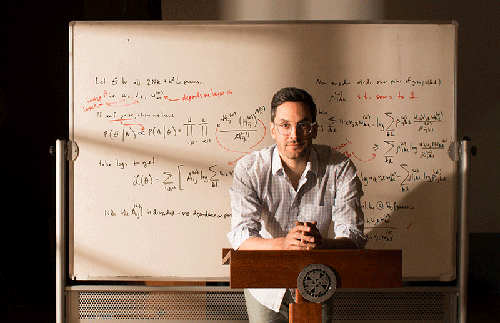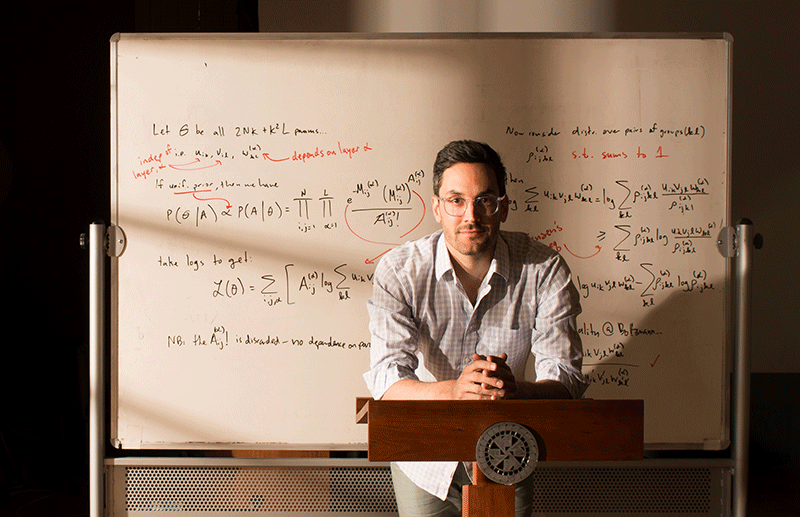Q&A: The Network that Lies Beneath
Daniel Larremore is multifaceted—he has a Ph.D. in applied math, publishes in physics journals, and is set to soon join the computer science department at the University of Colorado Boulder. These various pursuits make him a perfect fit for the Santa Fe Institute (SFI), a melting pot of researchers from different fields where Larremore, who is a network scientist, is completing his postdoc. Unrestrained by the conventions of traditional disciplines, network scientists borrow tools and ideas from multiple areas of research. Larremore finds this “freeing,” as it allows him to use the right tool for the problem at hand. Over the last few years, he has delved into networks that describe the mathematics of graphs, inequalities in academic hiring, and the evolutionary pathways of malaria parasites. Physics caught up with Larremore at a recent visit to SFI to find out more.
–Katherine Wright
Katherine Wright is a Contributing Editor for Physics.
What is a network?
My go-to systems for explaining networks are Facebook and Twitter. If you wipe away the names of the users and the meaning of the connections between them—like “friend” or “follower”—you’re left with a set of linked “nodes” called a network. Many different systems can be scrubbed down to this kind of structure, such as countries engaged in trade, terrorist networks, and genes that share traits. I find it fascinating that very different systems can be analyzed with the same methods.
When I visited SFI earlier this year, you gave a talk about your research on faculty hiring patterns. Could you summarize what you’ve found?
The lore among grad students is that you need a Ph.D. from a “great” school if you want to get a job at a university that’s merely “good.” To uncover whether there was truth to this narrative, my colleague Aaron Clauset and I have been looking at faculty hiring patterns in computer science and history departments as well as at business schools. We found that 85 to 90% of faculty members get their Ph.D.s from an institution that’s more prestigious than the institution that hires them. This result suggests that, for the vast majority of people, the lore holds—you do need a “higher-prestige” Ph.D. to get a job at a “lower-prestige” institution. And the prestige hierarchy is astoundingly strong. For example, those with a Ph.D. from the lower 75% of universities account for only 7% of faculty.
Any idea why?
Right now we can only speculate, in part because we don’t know what other factors are at play. Hiring creates these patterns but so do retention and mid-career moves. Issues like parental-leave policies, gender balance within a department, and a job’s location also play a role.
You were recently involved in a challenge to write a research paper in 72 hours. What was that like?
The idea was inspired by the 48 Hour Film Project, a contest in which a team of filmmakers have two days to write, shoot, and screen a film. The postdocs at SFI wanted to try a similar thing: Could we come up with a research project, execute it, and write it up in a short time? We gave ourselves 72 hours instead of 48 and, at the end of the three days, submitted what we had to arXiv.
What research ideas did you pick to explore?
The first time we did the challenge, we worked on the dynamics of beneficial epidemics—widespread outbreaks of infectious diseases that are actually good for you. This happens, for example, in agricultural crops, where a virus may protect pests from succumbing to a pesticide. It turns out that beneficial epidemics spread more rapidly than harmful ones, and we need new mathematics to describe them.
This year we studied how world records—in sports, hot-dog eating, the heights of buildings, etc.—have been beaten over the course of history. The frequency with which records have been broken can tell us about the mechanism that led to the new records. In Olympic running, for example, is a record broken because of an exceptional person or better equipment like shoes? We found that records are broken in biological and technological fields at a fairly constant rate, but in sport the pattern is “bursty,” often due to innovations in technique or equipment.
Why did you become a scientist?
As an undergrad, research wasn’t something I considered as a career. But while I was studying for my master’s degree I attended a colloquium on network science. I thought the topic was so cool. Within a week I was reading the speaker’s papers and trying to reproduce his results—I just got hooked. Now I get to work on scientific puzzles all day, and that’s amazingly fun, but also relevant to biology and how we interact socially.
Know a physicist with a knack for explaining his or her research to others? Write to physics@aps.org. All interviews are edited for brevity and clarity.





